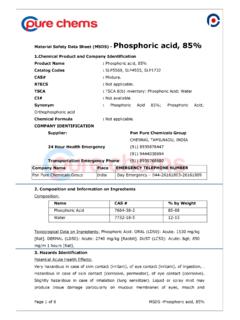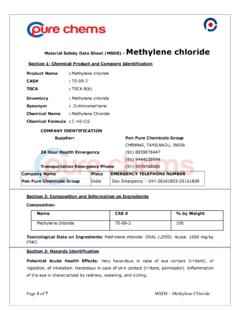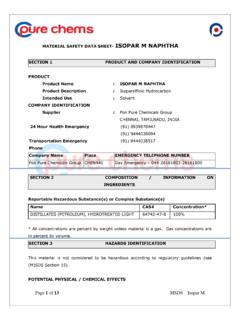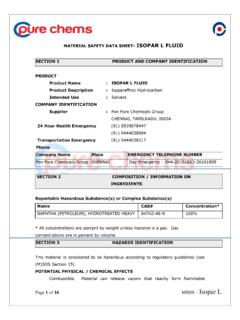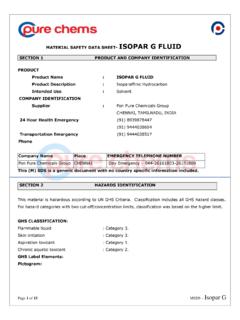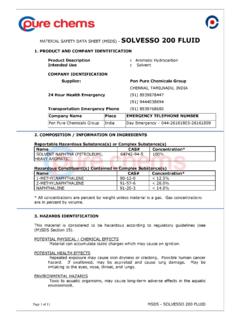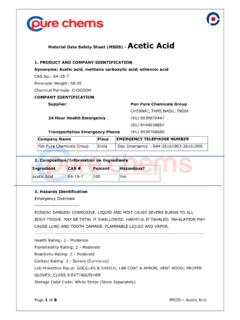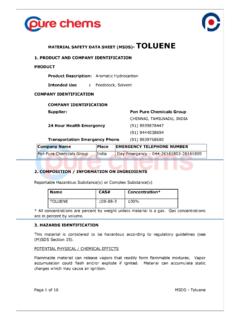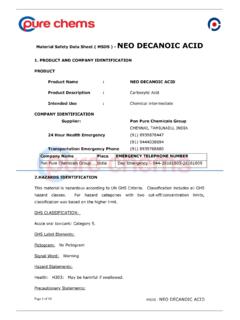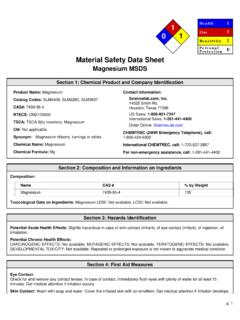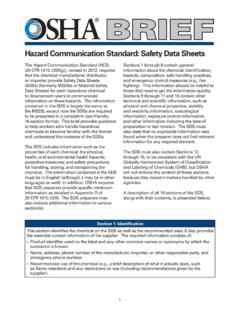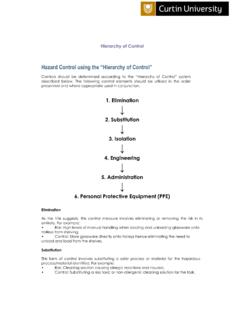Transcription of MATERIAL SAFETY DATA SHEET (MSDS) - FORMALDEHYDE
1 MATERIAL SAFETY DATA SHEET (MSDS) - FORMALDEHYDE . 1. Product Identification Synonyms : FORMALDEHYDE 37%; Formalin; Morbicid Acid; Methylene Oxide;. Methyl aldehyde CAS No. : 50-00-0. Molecular Weight : Chemical Formula : HCHO and CH3OH in water COMPANY IDENTIFICATION. Supplier: Pon Pure Chemicals Group CHENNAI, TAMILNADU, INDIA. 24 Hour Health Emergency (91) 8939878447. (91) 9444038694. Transportation Emergency Phone (91) 8939768680. Company Name Place EMERGENCY TELEPHONE NUMBER. Pon Pure Chemicals Group India Day Emergency 044-26161803-26161809. 2. Composition/Information on Ingredients Ingredient CAS No Percent Hazardous ---------------------------------------- ---------------------------------------- ----------------- FORMALDEHYDE 50-00-0 37% Yes Methyl Alcohol 67-56-1 10 - 15% Yes Water 7732-18-5 48 - 53% No 3. Hazards Identification Emergency Overview POISON!
2 DANGER! SUSPECT CANCER HAZARD. MAY CAUSE CANCER. Risk of cancer depends on level and duration of exposure. VAPOR HARMFUL. HARMFUL IF INHALED OR. ABSORBED THROUGH SKIN. CAUSES IRRITATION TO SKIN, EYES AND RESPIRATORY. TRACT. STRONG SENSITIZER. MAY BE FATAL OR CAUSE BLINDNESS IF SWALLOWED. CANNOT BE MADE NONPOISONOUS. FLAMMABLE LIQUID AND VAPOR. ---------------------------------------- ---------------------------------------- ------------------ Health Rating : 3 - Severe (Poison). Flammability Rating : 2 - Moderate Reactivity Rating : 2 - Moderate Contact Rating : 3 - Severe (Corrosive). Page 1 of 10 MSDS FORMALDEHYDE . Lab Protective Equip : GOGGLES LAB COAT VENT HOOD; PROPER. GLOVES; CLASS B EXTINGUISHER. Storage Color Code : Red (Flammable). Potential Health Effects The perception of FORMALDEHYDE by odor and eye irritation becomes less sensitive with time as one adapts to FORMALDEHYDE .
3 This can lead to overexposure if a worker is relying on FORMALDEHYDE 's warning properties to alert him or her to the potential for exposure. Inhalation: May cause sore throat, coughing, and shortness of breath. Causes irritation and sensitization of the respiratory tract. Concentrations of 25 to 30 ppm cause severe respiratory tract injury leading to pulmonary edema and pneumonitis. May be fatal in high concentrations. Ingestion: Can cause severe abdominal pain, violent vomiting, headache, and diarrhea. Larger doses may produce decreased body temperature, pain in the digestive tract, shallow respiration, weak irregular pulse, unconsciousness and death. Methanol component affects the optic nerve and may cause blindness. Skin Contact: Toxic. May cause irritation to skin with redness, pain, and possibly burns. Skin absorption may occur with symptoms paralleling those from ingestion.
4 FORMALDEHYDE is a severe skin irritant and sensitizer. Contact causes white discoloration, smarting, cracking and scaling. Eye Contact: Vapors cause irritation to the eyes with redness, pain, and blurred vision. Higher concentrations or splashes may cause irreversible eye damage. Chronic Exposure: Frequent or prolonged exposure to FORMALDEHYDE may cause hypersensitivity leading to contact dermatitis. Repeated or prolonged skin contact with FORMALDEHYDE may cause an allergic reaction in some people. Vision impairment and enlargement of liver may occur from methanol component. FORMALDEHYDE is a suspected carcinogen (positive animal inhalation studies). Aggravation of Pre-existing Conditions: Persons with pre-existing skin disorders or eye problems, or impaired liver, kidney or respiratory function may be more susceptible to the effects of the substance.
5 Previously exposed persons may have an allergic reaction to future exposures. 4. First Aid Measures Inhalation: Remove to fresh air. If not breathing, give artificial respiration. If breathing is Page 2 of 10 MSDS FORMALDEHYDE . difficult, give oxygen. Call a physician. Ingestion: If swallowed and the victim is conscious, dilute, inactivate, or absorb the ingested FORMALDEHYDE by giving milk, activated charcoal, or water. Any organic MATERIAL will inactivate FORMALDEHYDE . Keep affected person warm and at rest. Get medical attention immediately. If vomiting occurs, keep head lower than hips. Skin Contact: In case of contact, immediately flush skin with plenty of water for at least 15. minutes while removing contaminated clothing and shoes. Wash clothing before reuse. Thoroughly clean shoes before reuse. Get medical attention immediately.
6 Eye Contact: Immediately flush eyes with plenty of water for at least 15 minutes, lifting lower and upper eyelids occasionally. Get medical attention immediately. Note to Physician: Monitor arterial blood gases and methanol levels after significant ingestion. Hemodyalysis may be effective in FORMALDEHYDE removal. Use formic acid in urine and FORMALDEHYDE in blood or expired air as diagnostic tests. 5. Fire Fighting Measures Fire: Flash point : 60C (140F) CC. Autoignition temperature : 300C (572F). Flammable limits in air % by volume: LEL: ; UEL: 73. Explosion: Above flash point, vapor-air mixtures are explosive within flammable limits noted above. Containers may explode when involved in a fire. Fire Extinguishing Media: Water spray, dry chemical, alcohol foam, or carbon dioxide. Special Information: In the event of a fire, wear full protective clothing and NIOSH-approved self-contained breathing apparatus with full face piece operated in the pressure demand or other positive pressure mode.
7 Water may be used to flush spills away from exposures and to dilute spills to non-flammable mixtures. 6. Accidental Release Measures Ventilate area of leak or spill. Remove all sources of ignition. Wear appropriate personal protective equipment as specified in Section 8. Isolate hazard area. Keep unnecessary and Page 3 of 10 MSDS FORMALDEHYDE . unprotected personnel from entering. Contain and recover liquid when possible. Use non- sparking tools and equipment. Collect liquid in an appropriate container or absorb with an inert MATERIAL (e. g., vermiculite, dry sand, earth), and place in a chemical waste container. Do not use combustible materials, such as saw dust. If a leak or spill has not ignited, use water spray to disperse the vapors, to protect personnel attempting to stop leak, and to flush spills away from exposures.
8 7. Handling and Storage Store in a tightly closed container. Protect against physical damage. Store in a cool, dry well- ventilated location, away from any area where the fire hazard may be acute. Outside or detached storage is preferred. Separate from incompatibles. Containers should be bonded and grounded for transfers to avoid static sparks. Storage and use areas should be No Smoking areas. Use non-sparking type tools and equipment, including explosion proof ventilation . Wear special protective equipment (Sec. 8) for maintenance break-in or where exposures may exceed established exposure levels. Wash hands, face, forearms and neck when exiting restricted areas. Shower, dispose of outer clothing, change to clean garments at the end of the day. Avoid cross-contamination of street clothes. Wash hands before eating and do not eat, drink, or smoke in workplace.
9 Protect from freezing. Containers of this MATERIAL may be hazardous when empty since they retain product residues (vapors, liquid);. observe all warnings and precautions listed for the product. 8. Exposure Controls/Personal Protection Airborne Exposure Limits: -OSHA Permissible Exposure Limit (PEL): ppm (TWA), 2 ppm (STEL), ppm (TWA) action level for FORMALDEHYDE 200 ppm (TWA) for methanol -ACGIH Threshold Limit Value (TLV): ppm Ceiling FORMALDEHYDE , Sensitizer, A2 Suspected Human Carcinogen 200 ppm (TWA) 250 ppm (STEL) skin for methanol ventilation System: A system of local and/or general exhaust is recommended to keep employee exposures below the Airborne Exposure Limits. Local exhaust ventilation is generally preferred because it can control the emissions of the contaminant at its source, preventing dispersion of it into the general work area.
10 Please refer to the ACGIH document, Industrial ventilation , A Manual of Recommended Practices, most recent edition, for details. Personal Respirators (NIOSH Approved): If the exposure limit is exceeded and engineering controls are not feasible, a full facepiece Page 4 of 10 MSDS FORMALDEHYDE . respirator with a FORMALDEHYDE cartridge may be worn up to 50 times the exposure limit or the maximum use concentration specified by the appropriate regulatory agency or respirator supplier, whichever is lowest. For emergencies or instances where the exposure levels are not known, use a full-facepiece positive-pressure, air-supplied respirator. WARNING: Air purifying respirators do not protect workers in oxygen-deficient atmospheres. Irritation also provides warning. For Methanol: If the exposure limit is exceeded and engineering controls are not feasible, wear a supplied air, full-facepiece respirator, airlined hood, or full-facepiece self-contained breathing apparatus.
